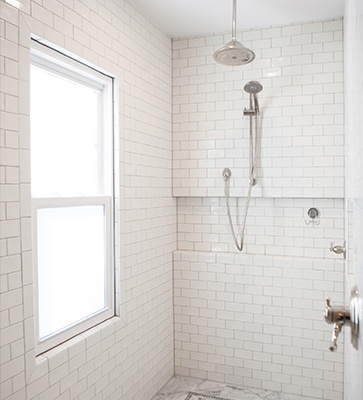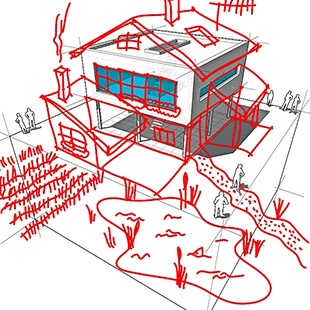Why Trends Aren’t Everything in Interior Design: The Case for Timeless Design
In the fast-paced world of interior design, trends come and go. One year, everyone’s obsessed with millennial gray; the next, green is all the rage. At Kaufman Construction, we believe trendy ideas have a place in today's homes, but we caution clients about getting too trendy with larger materials like flooring, kitchen cabinets and countertops, and bathroom tile and finishes.
What is Timeless Design?
Timeless design is all about creating spaces that feel classy, functional, and balanced, no matter when you walk into them. It’s about crafting a look that stands the test of time. Think about quarter-sawn oak trim, hardwood floors, butcher block or marble countertops, and subway tile. All are beautiful and enduring, having been around for centuries in some cases. Other trends have come and gone, but these finishes have stood the test of time.
Why Timeless Design Will Always Win
Adaptability
Timeless interiors offer flexibility. A neutral, well-balanced room can easily accommodate seasonal updates or a few trendy accents without losing its core aesthetic. For instance, you can swap out throw pillows or artwork to reflect current styles while maintaining a solid foundation.
Personalization
Trends often dictate what’s “in,” but timeless design allows you to focus on what’s meaningful to you. An antique hutch passed down through generations or a unique work of art can coexist beautifully within a timeless framework, creating a space that’s truly your own.
Timeless Styles
Certain styles have stood the test of time and continue to inspire homeowners and designers alike. Incorporating elements of these styles can further enhance the longevity of your space.
Devan appreciates Arts & Crafts, Prairie, Mission Styles, and Contemporary design, often updating these styles with trendy accessories and balancing them with traditional features. Jackie, our designer, favors a blend of Craftsman and Modern-Traditional design, using moody paint colors, traditional rugs and furniture, and adding a trendy throw pillow on the sofa.
-
Modern-Traditional
Key Features: Hardwood floors, natural stone, arched doorways, paneling, and symmetry combined with soft textures and clean lines honor the beauty of tradition while adapting to contemporary tastes.
Why It’s Timeless: Modern-traditional design has the best of both worlds: it gives a sense of classic craftsmanship while offering a canvas for modern style.
-
Modernism
Key Features: Clean lines, minimal decoration, and an emphasis on materials like wood, stone, steel, and glass, which age gracefully and reinforce longevity.
Why It’s Timeless: Modernist design prioritizes universality and adaptability, seamlessly blending with other styles.

-
Mid-Century Modern
Key Features: Open floor plans, large windows, and a focus on high-quality materials such as teak, walnut, leather, and metal.
Why It’s Timeless: MCM focuses on thoughtful design principles, quality materials, and versatile aesthetics. It can complement a wide variety of other design styles and pairs well with contemporary, traditional, and eclectic interiors.

-
Craftsman (or Arts and Crafts)
Key Features: Built-in cabinetry, detailed woodwork, and natural materials like wood, stone, and brick which bring warmth and texture to the space.
Why It’s Timeless: Craftsman homes emphasize quality craftmanship, natural materials, and resonate with people looking for grounded, proportioned, and balanced design. It also pairs well with other design styles.

-
Traditional Farmhouse
Key Features: Exposed beams, barn doors, shiplap, and cast-iron sinks paired with neutral tones like creamy whites, beiges, warm grays, and earthy colors.
Why It’s Timeless: It emphasizes imperfections such as weathered wood, distressed finishes, and vintage or antique pieces like heirloom furniture, creating a warm and inviting space in any time period.
How to Incorporate Timeless Elements
We think it’s wise to consider more timeless options for your floors, trim, cabinets, backsplashes, and tile. Following trends when it comes to areas of the home that are easy to change like light fixtures, paint, furniture, and accessories, keeps your home fresh without needing a remodel every few years.
Focus on main materials throughout the home for timeless elements.
- Flooring
- Trim & Crown Molding
- Tile
- Cabinetry
Use well-made items that withstand daily use.
- Wood
- Natural Stone
- Brick
- Metal
Go for trends in areas of the home that can easily change.
- Light Fixtures
- Paint
- Furniture
- Accessories
Final Thoughts
Trends can be inspiring, but they should never dictate your entire approach to interior design. By focusing on timeless principles and drawing inspiration from enduring architectural styles, you can create a home that’s not only beautiful today but will remain so for years to come. After all, true craftsmanship isn’t about keeping up—it’s about creating something that lasts.
Sources: kaufmanconstruction.com








